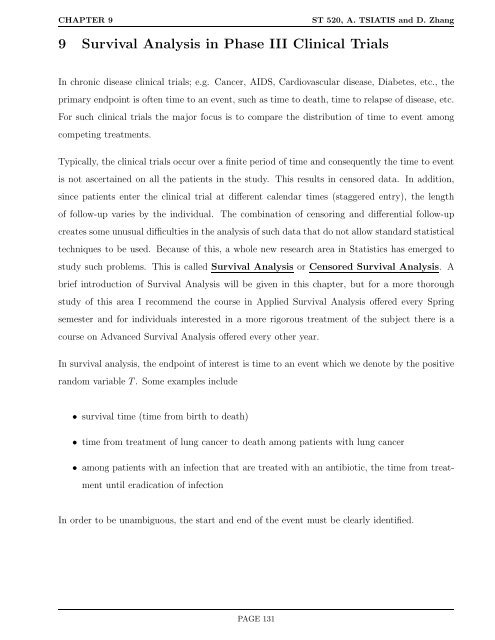ST 520 Statistical Principles of Clinical Trials - NCSU Statistics ...
ST 520 Statistical Principles of Clinical Trials - NCSU Statistics ...
ST 520 Statistical Principles of Clinical Trials - NCSU Statistics ...
You also want an ePaper? Increase the reach of your titles
YUMPU automatically turns print PDFs into web optimized ePapers that Google loves.
CHAPTER 9 <strong>ST</strong> <strong>520</strong>, A. TSIATIS and D. Zhang<br />
9 Survival Analysis in Phase III <strong>Clinical</strong> <strong>Trials</strong><br />
In chronic disease clinical trials; e.g. Cancer, AIDS, Cardiovascular disease, Diabetes, etc., the<br />
primary endpoint is <strong>of</strong>ten time to an event, such as time to death, time to relapse <strong>of</strong> disease, etc.<br />
For such clinical trials the major focus is to compare the distribution <strong>of</strong> time to event among<br />
competing treatments.<br />
Typically, the clinical trials occur over a finite period <strong>of</strong> time and consequently the time to event<br />
is not ascertained on all the patients in the study. This results in censored data. In addition,<br />
since patients enter the clinical trial at different calendar times (staggered entry), the length<br />
<strong>of</strong> follow-up varies by the individual. The combination <strong>of</strong> censoring and differential follow-up<br />
creates some unusual difficulties in the analysis <strong>of</strong> such data that do not allow standard statistical<br />
techniques to be used. Because <strong>of</strong> this, a whole new research area in <strong>Statistics</strong> has emerged to<br />
study such problems. This is called Survival Analysis or Censored Survival Analysis. A<br />
brief introduction <strong>of</strong> Survival Analysis will be given in this chapter, but for a more thorough<br />
study <strong>of</strong> this area I recommend the course in Applied Survival Analysis <strong>of</strong>fered every Spring<br />
semester and for individuals interested in a more rigorous treatment <strong>of</strong> the subject there is a<br />
course on Advanced Survival Analysis <strong>of</strong>fered every other year.<br />
In survival analysis, the endpoint <strong>of</strong> interest is time to an event which we denote by the positive<br />
random variable T. Some examples include<br />
• survival time (time from birth to death)<br />
• time from treatment <strong>of</strong> lung cancer to death among patients with lung cancer<br />
• among patients with an infection that are treated with an antibiotic, the time from treat-<br />
ment until eradication <strong>of</strong> infection<br />
In order to be unambiguous, the start and end <strong>of</strong> the event must be clearly identified.<br />
PAGE 131
















